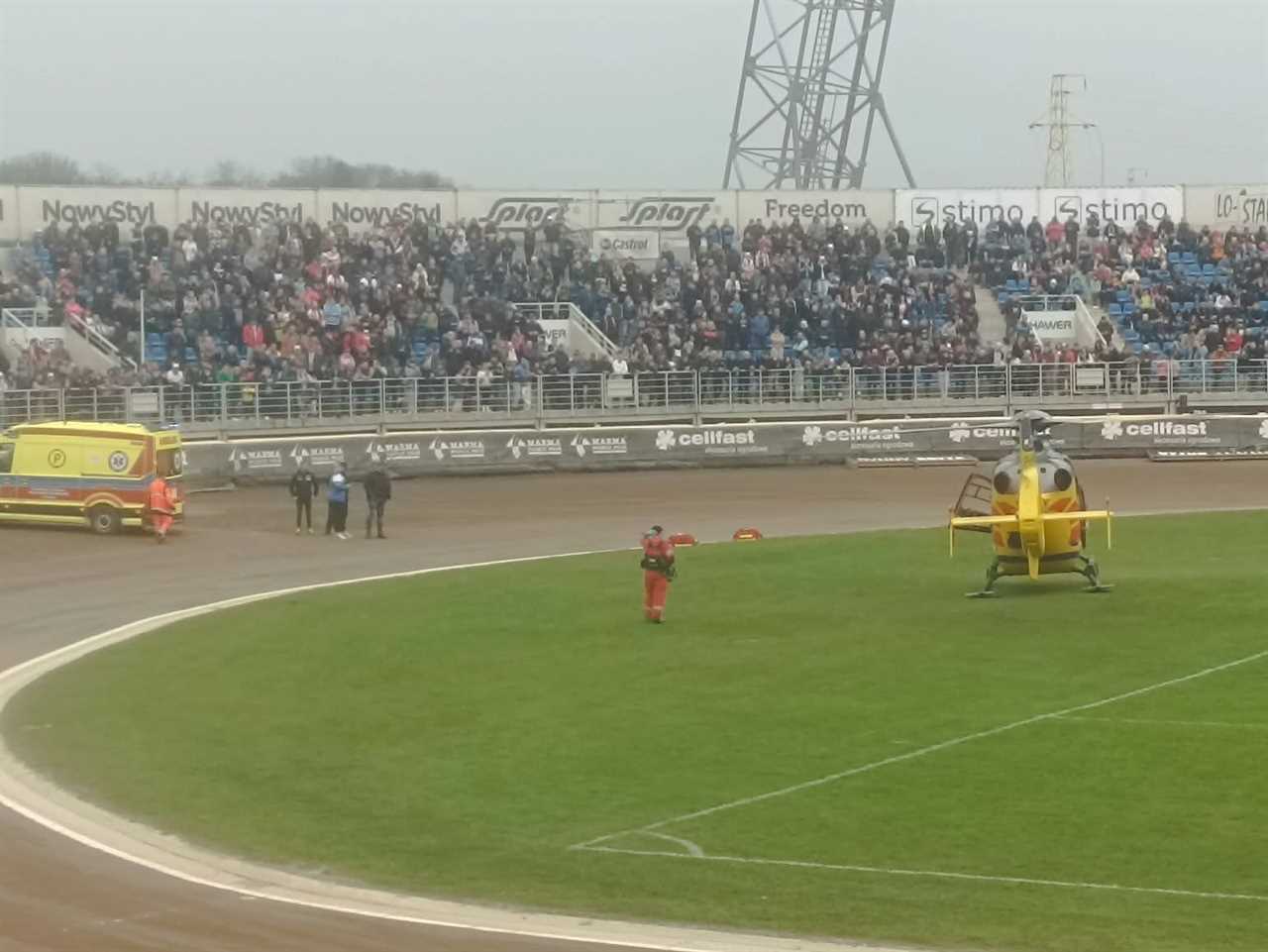
Speedway Star Airlifted After Pile-Up
Sheffield's own Tai Woffinden, a celebrated figure in speedway racing, was involved in a dramatic crash during a race in Poland last Sunday. The incident occurred in Krosno, where a three-man collision led to Woffinden being airlifted to a local hospital.
Serious Injuries Reported
According to sources in Poland, the three-time World Champion sustained significant injuries, including a broken femur and fractures to both hands. These injuries have raised concerns about his immediate future in the sport, especially considering his recent return from a prior injury.
Timing Adds to the Shock
The crash comes just days after Woffinden attended a media event in Sheffield. At 34, he was scheduled to make his season debut in the UK this Thursday at a race in Birmingham. The sudden accident has thrown his racing calendar into uncertainty.
Team Requests Privacy
In response to the incident, Sheffield Speedway released a statement urging the public and media to refrain from spreading unverified information. "Out of respect for Tai and his family, we politely ask supporters not to respond to, or share, any rumours," the statement read. They assured fans that an official update would be provided when appropriate.

Return from Previous Injury
Woffinden's current predicament follows his recent comeback from a severe elbow injury that had cut his 2024 season short. That injury also occurred in Poland, underscoring the inherent dangers of the sport he passionately pursues.
Passion for the Sport Undeterred
Just a week prior to the crash, Woffinden spoke openly about the risks involved in racing. "I’m racing a motorbike with no brakes," he remarked at the ROWE Motor Oil Premiership media day. "I’m not in a car with a roll cage. It comes with the sport. It’s dangerous."
Looking Ahead
Despite the setbacks, Woffinden remains focused on his goals. He expressed a strong desire to win the British Championship, participate in the Grand Prix qualifiers, and rejoin the Grand Prix series. "I’ve had a lot of injuries but I’ve got a lot to achieve still," he stated.
Support from the Racing Community
The speedway community has rallied around Woffinden, offering support and well-wishes during his recovery. Fans and fellow racers alike are hoping for his swift return to the track, recognizing his contributions to the sport and his resilient spirit.

Impact on Upcoming Season
The injury not only affects Woffinden but also has implications for his team and the upcoming races. With his first UK meeting of the season now uncertain, Sheffield Speedway and his club Rzeszow will need to adjust their strategies and line-ups in his absence.
Reaffirming Commitment
Woffinden's dedication to speedway racing is evident in his words and actions. Even after multiple injuries, his commitment to the sport remains unwavering. This latest incident serves as a stark reminder of the physical demands and risks that come with high-speed racing.
Awaiting Official Updates
As Woffinden battles his injuries, official updates from Sheffield Speedway and medical professionals will provide more clarity on his condition and the expected timeline for his recovery. The racing community remains hopeful for positive news and his return to the sport he loves.
Frequently Asked Questions
What steps does Formula 1 take to be more environmentally friendly?
Formula 1 adopts several measures in order to become more environmentally friendly. One of the key initiatives is transitioning to biofuels and aiming for a net-zero carbon footprint by 2030. The sport is researching advanced sustainable fuel technologies to reduce greenhouse gas emissions. Efforts around logistics, such as carbon offsetting and greener travel methods, are being implemented. F1 works closely with partners in order to improve the recycling of components and to reduce waste.
What improvements have been made to the fuel efficiency of Formula 1 engines in recent years?
Several key innovations have improved the fuel efficiency of Formula 1 engines. Turbocharging allows for smaller displacement engines to produce greater power with less fuel. Direct fuel injection provides precise fuel delivery for better combustion efficiency. Energy Recovery System (ERS), which captures and reuses waste energy, reduces the fuel requirement. The efficiency and sustainability of F1 power units are improved by these and other innovations.
Can you describe how telemetry is utilized in Formula 1?
Telemetry in Formula 1 refers to a sophisticated system which transmits data in real-time from the cars, back to the team headquarters and then the engineers working on the pitwall. This data can include engine information, brakes or tires, fuel, and the inputs of the driver. Engineers use telemetry to monitor the car's performance, make strategic decisions, and identify potential issues before they become critical. Telemetry can be used to maximize the performance of a car and its driver during a race.
How has Formula 1's DRS system improved overtaking ability?
Drag Reduction System (DRS), a Formula 1 feature, reduces aerodynamic resistance to allow for better overtaking. The system allows the rear flap to open in certain conditions. This is usually when a car's distance from the vehicle ahead is less than a second. This reduces the downforce, increasing speed while facilitating passing maneuvers. DRS helps overcome the challenge of aerodynamic air turbulence coming from the leader car which can make passing difficult.
What are the most common materials used to construct a Formula 1 chassis?
Carbon composites is the primary material used in Formula 1 chassis. The material is preferred for its strength-toweight ratio. It offers exceptional rigidity and low weight. Materials like aluminum and titanium, as well as advanced polymers, honeycomb structures and crash-absorbing materials, can also be used.
How do the rules of Formula 1 influence car design and technology?
Formula 1 regulations and rules are set out by the FIA. These have a huge impact on design and technology. These regulations define parameters such as dimensions of the vehicle, engine specifications and aerodynamics, safety features, etc. To stay competitive, teams must innovate constantly within these limitations. Rules evolve to promote closer racing, safety advancements, and sustainability goals, directly influencing technological developments within the sport.
Statistics
- Formula 1 races on average have over 300 sensors on a car, generating more than 1.5 billion data points over a race weekend.
- Formula 1 cars can achieve lateral acceleration in excess of 5 g during cornering, which is about five times the force of gravity.
- Modern Formula 1 car chassis are required to withstand a frontal crash test with a peak deceleration of no more than 25 g.
- The drag reduction system (DRS) can increase a Formula 1 car's straight-line speed by approximately 12-15 km/h when activated.
- Formula 1 engines can rev up to 15,000 RPM, a decrease from the 18,000 RPM limit set prior to the 2014 regulation changes.
- A typical Formula 1 car's brake discs can reach temperatures of over 1,000 degrees Celsius during heavy braking.
- Since the hybrid power units were introduced in 2014, thermal efficiency has increased from around 29% to surpass 50%, a remarkable figure compared to standard road car engines.
- Formula 1's research into sustainable fuel aims to create a 100% sustainable fuel for use in F1 engines by the mid-2020s.
External Links
How To
How to follow the latest developments in racing simulation for F1 Teams
Follow the advancements made in F1 racing simulation and how they are used to train drivers and develop vehicles. Follow the advancements in virtual modeling, software upgrades and other improvements that will improve the accuracy. Track how teams incorporate feedback from drivers to refine the simulator experience, and note the increasing reliance on simulation for strategy planning, particularly for new or modified circuits.
Did you miss our previous article...
https://sportingexcitement.com/formula-1/jochen-mass-withdraws-from-public-life-after-medical-emergency
 CricketBoxingFormula 1GolfHorse RacingPremier LeagueTennisPrivacy PolicyTerms And Conditions
CricketBoxingFormula 1GolfHorse RacingPremier LeagueTennisPrivacy PolicyTerms And Conditions
